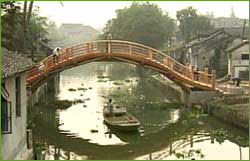
|
 |
China's Age of Invention Part 2 | Back to Part 1 NOVA: What influence did these printing innovations have on Chinese history? Yates: Well, that's a question that brings us into the political realm. One of the major social changes that took place in the Song Dynasty was that the old aristocratic order ended and the nature of the social elite changed dramatically. Specifically, a new class of scholar-officials came to the fore. To a large extent, they were chosen on the basis of their success in the official examinations. The scholars had to be very familiar with the Confucian classical texts, which were originally produced more than 1,000 years earlier. As a consequence, political power and social dominance were dependent upon knowledge of the written text. Printing allowed books to be very much more widely disseminated and therefore allowed political power to be shared on a much broader scale than it had been in the past. The class of so-called literary or scholar-officials that evolved basically dominated China until the 20th century with the founding of the Republic in 1911. NOVA: Was it a type of meritocracy? Yates: That's right. Official status was open to individuals who studied hard and passed the examination. A very important development that Joseph Needham points out is that doctors were tested on their medical knowledge. It would be impossible to measure people's ability and skill and knowledge without examinations. Could you imagine education without examinations? NOVA: Without exams, you might be out of a job. Yates: Yes. And our society would not be able to survive. We depend on this Chinese examination system that was brought to the West. Before the introduction of examinations and the bureaucratic system that came from China, society was very much hierarchical and dependent upon who you were, in what family or occupation you were born into, and your social status. In democratic systems, you know, your status ideally depends upon equality of opportunity, and that's really one of the things that the Song ultimately gave to the rest of the world, along with all these other technologies.
Yates: A major role. The Chinese political philosophy held that the emperor and his officials were responsible for the welfare of the people - and that included the country's economic welfare. With that in mind, they took the agricultural innovations being made in one small region of China and disseminated printed texts about it across the entire Empire. One of the major agricultural innovations that we talk about in the NOVA documentary is that a new type of rice was introduced from Vietnam that grew faster. It prevented famine and allowed people to grow a double crop of rice each year, giving them a surplus that they could sell on the open market. This led to more wealth in the rural sector. They became more than subsistence farmers and began growing crops they could sell in the open market for cash. This spurred on the development of a commercial and agricultural economy, and also fed the increased urbanization that Marco Polo is reputed to have seen. So it was a very complex process.
Yates: That's right. In order for the markets to develop and the circulation of goods to be achieved, for example, you needed a good system of communication. So one of the other major developments in the Song Dynasty was the rapid expansion of the canal and of the waterway system, which was particularly true in the southeast and southern parts of China. To move goods from place to place in the open seas the Song developed the mariner's compass. Originally, the compass had been developed for divination purposes, a sort of magnetic spoon going back as early as the Han Dynasty 1,000 years before. The Song began to trade with Southeast Asia, because in the north they were cut off from the Silk Road by other empires. So they started to use the compass for navigational purposes to help them know the direction in which to sail. Gradually the Chinese people traveled to Southeast Asia and into Taiwan, of course, and into the Philippines and places like that. In the early part of the Ming Dynasty, after the Mongols, the Chinese Admiral Zheng He led several significant expeditions around to India and even as far as Africa. Chinese porcelains have been found as far south as Zanzibar and Tanzania. This was just before the Age of Exploration in the West. Accompanying the invention of the compass were other inventions, such as the development of new types of locks along the canals. The Chinese previously had invented the sternpost rudder, actually in the Han Dynasty, but the sternpost rudder was very, very important for controlling a vessel. They'd also invented sails that could move. In earlier times, in the Mediterranean, sails were fixed. They had to wait for the wind to change in order to be able to move. But the Chinese invented sails that could be trimmed so that they could travel regardless of which way the wind was blowing. They also developed the structure of the ship's hold, dividing it into different watertight compartments. The result was that if one chamber in the hull sprang a leak, then it wouldn't damage the rest of the cargo. If all oil tankers had double hulls like this, they wouldn't cause the kind of ecological problems that they've caused. All of these technological developments were interconnected with the commercialization and urbanization.
Yates: That's right. During the Song Dynasty, the population of China grew to about 100 million people, which made it a very large country. With the expansion of the waterways, you needed bridges so that people could get from one side of the river to the other in an easy way. So that's why you had the development of the bridge, and specifically the Rainbow Bridge. It was developed in Shandong province, which has mountainous terrain and where previous bridges were often washed away in spring floods. So a retired prison guard designed a Rainbow Bridge that was built up from the banks. It could span a waterway without having any central pillars that could be washed away by the floods. The bridge that NOVA built was imitating one in Kaifeng, the capital of northern Song China, that was built over the Bian Canal, which was used to bring grain up from the rich rice-growing regions of Southeast China. All of this was connected - transportation, commercialization, technological innovations, and urbanization. The Song Dynasty was a time of remarkable change in so many different ways. NOVA Builds a Rainbow Bridge | Bridge the Gap | Nature's Miracle Material China's Age of Invention | Resources | Transcript Medieval Siege | Pharaoh's Obelisk | Easter Island | Roman Bath | China Bridge | Site Map Editor's Picks | Previous Sites | Join Us/E-mail | TV/Web Schedule About NOVA | Teachers | Site Map | Shop | Jobs | Search | To print PBS Online | NOVA Online | WGBH © | Updated November 2000 |
 Faster growing rice distributed during the Song
Dynasty helped prevent famine.
Faster growing rice distributed during the Song
Dynasty helped prevent famine.
 The Chinese invented the compass and then used it to
travel the open seas.
The Chinese invented the compass and then used it to
travel the open seas.
 This Rainbow Bridge, built by a NOVA team of experts,
was invented during the Song Dynasty.
This Rainbow Bridge, built by a NOVA team of experts,
was invented during the Song Dynasty.